|
Monday, October 24, 2011
Progress Notes
Recently, Debbie Simmons sent me some photos she took the week that our fall scenery was displaying its most color. Debbie had driven around the area to select a few places where the autumn scenery was most vivid. One of those was around Henley. The first photo wasn’t scenery but was a shot of the old abandoned mill in Henley (photo 01).
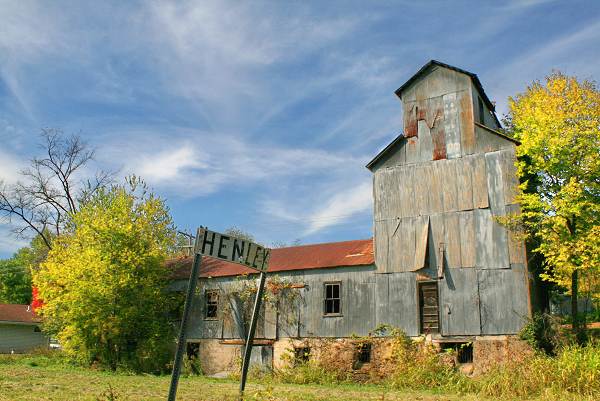
01 Old Henley Mill
The second photo was a beautiful view of the Osage River near Henley (photo 02).

02 Osage River near Henley
The third photo was an unusual one taken from underneath a natural stone bridge (photo 03).
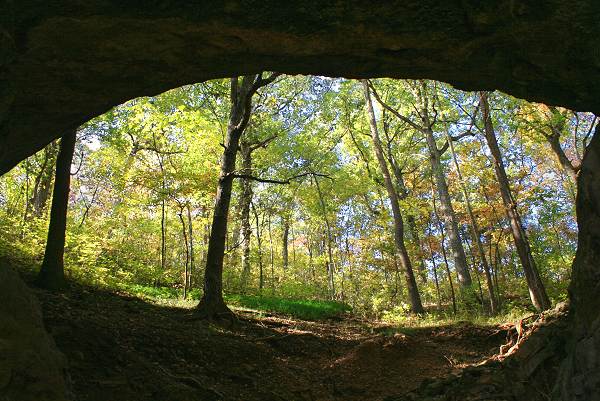
03 Cave Mouth
You can read all about Henley at this previous Progress Notes.
Debbie then went over to an area north of Bagnell where the old Walnut Grove school is located and took some pictures of the school (photos 04 - 08).
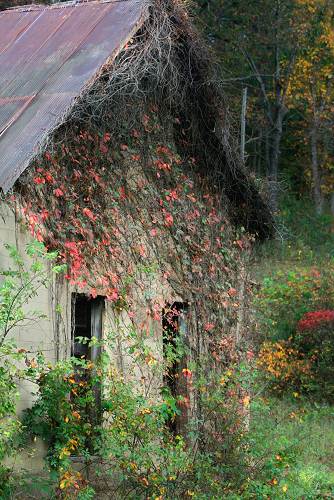
04 Walnut Grove School
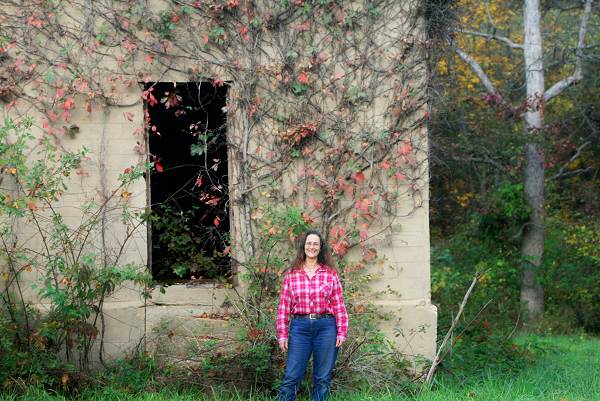
05 Moureen Read in front of Walnut Grove School
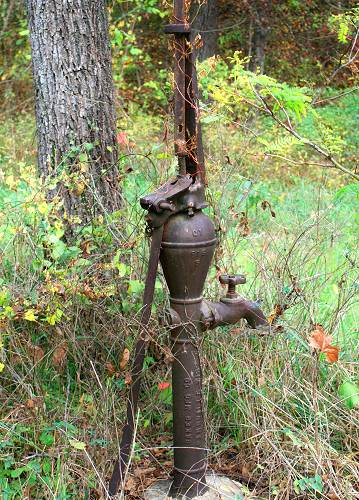
06 Walnut Grove School Well Pump
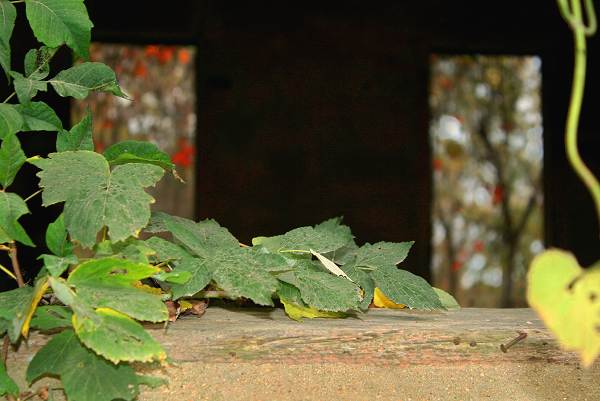
07 Walnut Grove School Window
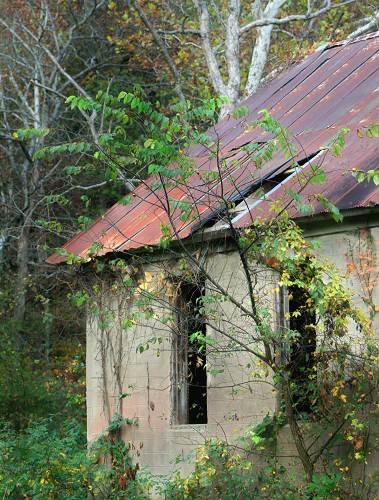
08 Walnut School (side view)
Here is a map where you can see where the school is located a short distance north of Highway 54 in the Meads Flat area (photo 09).
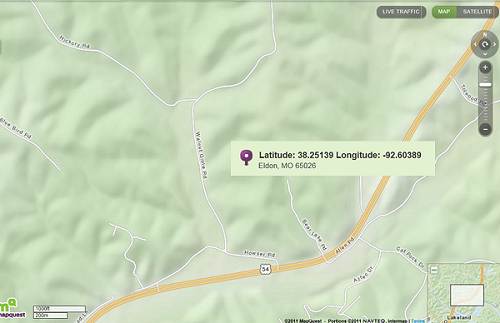
09 Walnut Grove School location on Map
Click image for larger view
Walnut Grove was one of the many one room schools the county had years ago which at one time numbered up to about 100 schools. Some of the several teachers there included T.E. Vaughan in 1898 (photo 10), Oliver Brockman in the early 1900’s (photo 11), and Ruth McCommons Barrons in the 1930’s (photo 12).
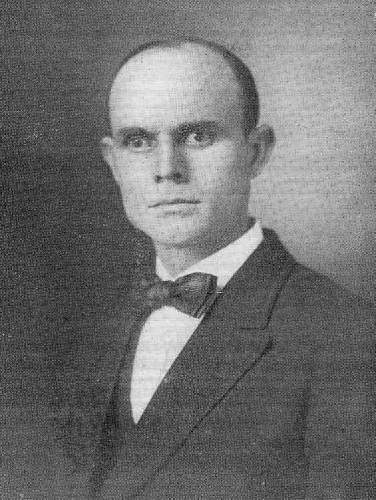
10 T.E. Vaughan
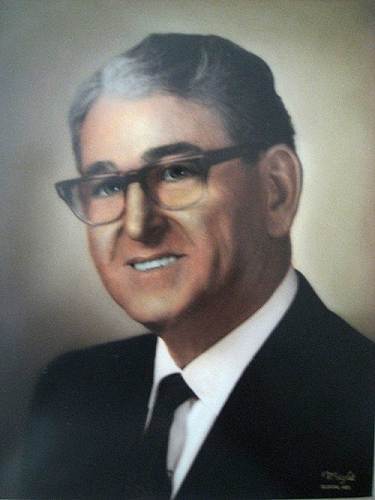
11 Oliver Brockman
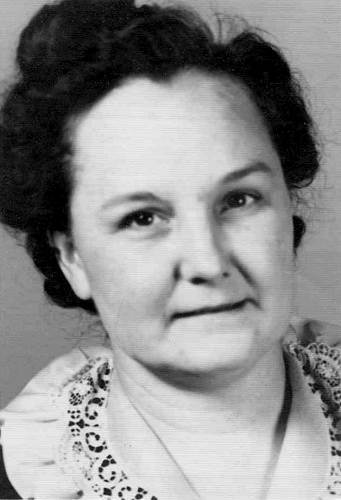
12 Ruth McCommons Barron
The name of the school relates to the fact that it is surrounded by a grove of walnut trees according to James R. Pruitt on this website.
The story of the one room schools in Miller County and the early educational system of the county in general is well written by Clyde Lee Jenkins (photo 13) in his book Jenkins’ History of Miller County.
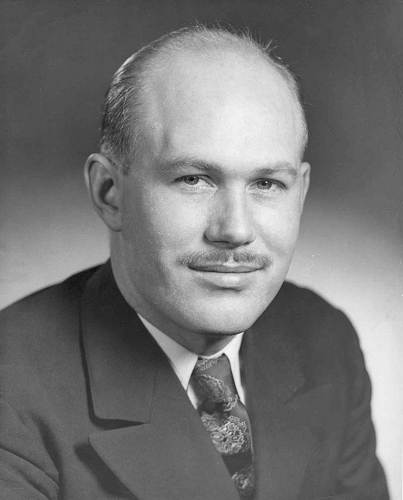
13 Clyde Lee Jenkins
The narrative is a long one but I am copying all of it here since due to the scarcity of Jenkins’ book few would have opportunity to read it otherwise:
Judge Jenkins’ History of Miller County
p. 239
Early Education
It must be remembered that after White men crossed the Missouri River, hardy pioneers carried muzzle loading rifles, navy revolvers, whiskey, and civilization into the land of the Osage Indians. Step by step these pioneers disputed their way with the disappearing buffalo, the grunting bear, the howling timber wolf, and the long nosed, hazel splitter hog into the area of what is now Miller County.
Note: The common hog of the early days was known as the “Hazel Splitter.” He was a long, lank animal, long in the legs as well as in body, and in early spring when the mast in the woods had become scarce he well represented his name. Putting up and feeding was not the fortune of the hog of the early settlers. A good year for mast was the hog’s glory and he got fat, and man profited by killing him, but a failure of this wild crop of swine food changed all this, and man and hog both suffered in those early days accordingly.
Upon reaching the area of later day Miller County these earlier settlers opened vast unbounded areas of virgin prairie, groves, hills, forests, and wilderness, allowing no interference with their holdings. Among them were no castes, they were overlord of their estates as well as tillers of the soil. But no single thing was more marked, distinctive, or encouraging for the future than the earnest desire of most of the earlier settlers for information and education.
There is no record of schools in the county until the middle 1830’s. The first teacher, it is believed by most historians, was J. Milton Houston, a Baptist minister, who taught a subscription school on the farm of A.G. Wilkes near old Rocky Mount (photo 14).
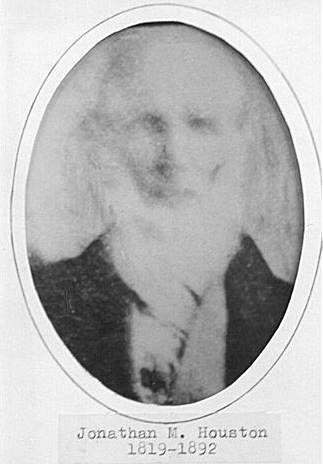
14 Jonathan Milton Houston
About this time a subscription school was taught in the Smyrna Church House, a log building, in the Big Richwoods.
Without any doubt the first schoolhouse in the territory of Miller County was a log building raised in the old Curry district about 1834. It was located in Section 17, township 39N Range 13W, on the later day farm of Mr. Peach Wall. The first school in this building was taught by a traveling preacher. The second schoolhouse, a log building, was raised in 1835, on the plantation of John Davis in the Little Richwoods.
Note: Here is a recent photo of the old Curry School, a frame building built long after the original log building in the early half of the 1900’s (photo 15).
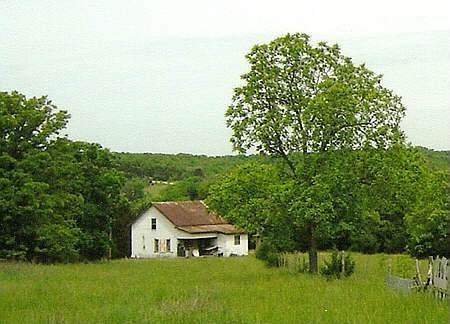
15 Curry School - 2006
The first Constitution of the State of Missouri provided that one school or more be established in each township as soon as practicable and necessary so the poor could be taught gratis. These first schools were not public schools in the modern sense. They were empowered to assess rate bills on patrons of the school district of sufficient means to bear the expense. This permitted free tuition for orphan and indigent children.
The first charter school in Missouri was at Ste. Genevieve in 1808.
About fifty such schools were in existence in Missouri when the first general school law was enacted by the legislature in 1833. Under the law of 1835, the system of public taxation for schools commenced, limited at first to building needs.
It was two years after Miller County was organized before the constitutional clause limiting educational benefits to the poor was removed. In 1838, provision was made for a State Superintendent of Public Instruction, for a County Board of Superintendent of Public Instruction, for a County Board of Education, and for a Township Board. However, this law was too advanced in time and little was done under it. The Secretary of State was made ex officio state school officer in 1841, and in 1853, the state superintendence was created.
The Act of Congress admitting Missouri into the Union set apart the sixteenth section of every Congressional Township for school purposes. On May 2, 1837, at the house of William Miller, during the first session of the Miller County Court, Thomas S. Witten presented to the Justices a petition from inhabitants in Congressional Toswnship No. 40, in Range Number 15, which requested sale of the land in the 16th section of said township, at public auction, for school purposes (photo 17).
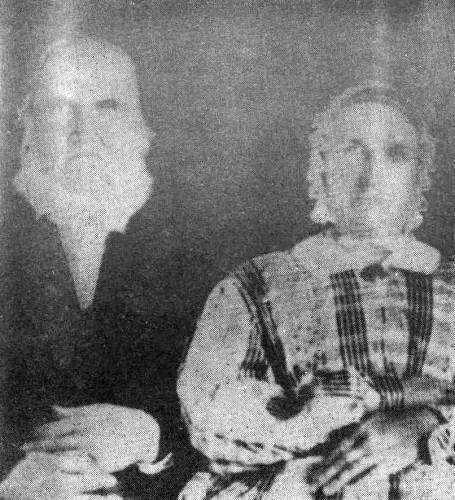
17 William and Sarah Miller
This was the Congressional Township in which the Village of Bagnell is now located and the County Court ordered the land sold.
The first schoolhouse erected after the formation of Miller County was a log building, raised in June, 1838, at Bilyeu’s Mill in Richwoods Township. A summer term of school was taught here in 1838. The second schoolhouse in Miller County was raised at Sarter’s Mill on the Saline Creek. A fall term of school, beginning in October, 1838, was taught here. The third schoolhouse was raised on the Gott Plantation in Glaze Township. A summer term of school was taught here in 1839. Designated the Little Richwoods school, the name was soon forgotten, But Gott continued into modern times.
In 1840, Miller County was organized into school districts by order of the County Court. Fourteen school districts were established. Each school district was a Congressional township, or fractional part thereof, making them of large size. It was not uncommon for some students to walk fifteen miles to school.
The fourth schoolhouse in Miller County was erected on Hite’s Old settlement. In 1841 a fall term of school was taught here. The Congressional Township in which this school was located appears to be the only school district in Miller County organized for school purposes under the law of 1839.
On April 6, 1844, the inhabitants of Congressional Township No. 42, Range 15W, met at Pleasant Mount, and organized the township for school purposes pursuant to the provisions of an act of the General Assembly, approved February 9, 1839, which provided for the organization, support, and government of common schools.
George C. Adcock was appointed Commissioner of this Township School District by the County Court; Samuel J. Jones and Alfred M. Houston appointed inspectors of the sub district schools (photo 18).
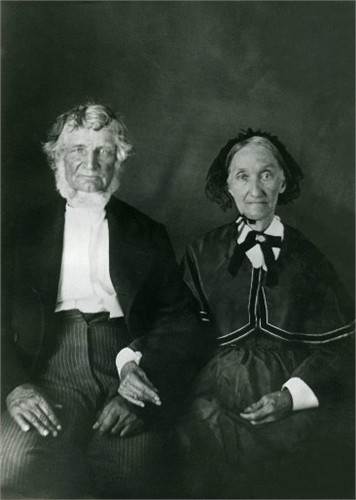
18 Alfred and Melinda Houston
In 1858, there were five sub district schools in Congressional Township School District No. 2, but only one school building. Four schools were held and taught in church buildings or private dwellings.
It appears the first enumeration of children for school purposes in Miller County was taken in 1847. A justice of the Peace in each municipal township was designated by the County Court to ascertain the number of children between the age of six years and under twenty, residing in each township on December 31, 1848.
This enumeration of children was made by Esquires Isaac Bond for Jim Henry Township; William Wood for Osage Township; Jonathan Blevans for Richwoods Township; David Reed for Glaze Township; E. H. Gibson for Equality township; and Samuel J. Jones for Saline Township.
There were 258 children enumerated in Saline Township; 192 children in Jim Henry Township; 225 in Richwoods; 176 in Glaze; 144 in Osage; and 134 in Equality; total 1,129. One year later there were 232 children enumerated in Saline Township; 211 children in Jim Henry Township; 208 in Richwoods; 181 in Glaze; 165 in Osage; and 125 in Equality; total 1,122.
The apportionment of the first state school fund monies awarded to Miller County shown in the record books of the County Court, in 1848, amounted to 38 ¾ cents for each child enumerated. The second apportionment of state school fund monies, in 1849, amounted to 39 cents for each child enumerated.
The fifth schoolhouse in Miller County was raised on the South bank of the Osage River at the Elm Ford crossing. In 1841 a fall term of school was taught here. Congressional Township School District No. 10, in which this school was located, was the first school district organized under the law of 1845.
On September 16, 1848, the inhabitants of Congressional Township No. 40, Range 15W, school district No. 10, met at the meeting house near the mouth of Little Gravois, the Gilgal Church House, and organized the township for school purposes pursuant to the provisions of an act of the General Assembly, approved March 27, 1845, which provided for the organization, support, and government of Common Schools. Hugh Challes was appointed Commissioner of this district by the County Court; Gabriel Cotton and J. Milton Houston appointed inspectors of the sub district schools.
The sixth school house in Miller County was raised near the Osage River by the mouth of Gum Creek. In 1843 a summer term of school was taught. In 1855 this building was abandoned with school held and taught in a building at Tuscumbia, raised for school purposes, and privately owned by Daniel Cummings and Champ Smith (photo 19).
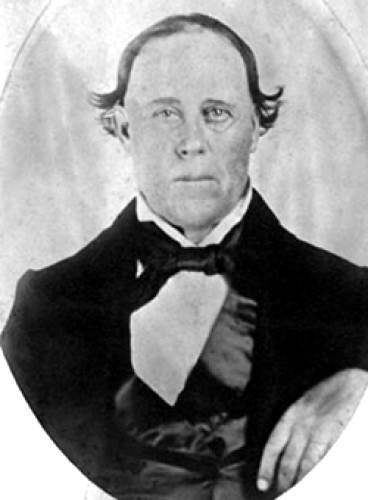
19 Champ Smith
The seventh schoolhouse in Miller County was raised on the Castleman Plantation on Brushy Fork Creek. A summer term of school was taught here in 1854. On February 24, 1854, the inhabitants of Congressional Township school District No. 13, met at the house of H.P. Gardner, and organized the township for school purposes under the law of 1845.
Eventually, four sub districts were established in township School District No. 13, becoming Elliott, Hickory Point, Mace, and the Spearman districts.
The eighth schoolhouse in Miller County was erected on the William Thornsberry Improvement in Glaze Township. A fall term of school was taught here in 1850.
On September 22, 1849, the inhabitants of Congressional Township School District No. 4, met at the house of John W. Johnston, near the Saline Creek, at ten o’clock in the forenoon, and organized the township for school purposes pursuant to the law of 1845. The County Court appointed John W. Johnston, Commissioner; Champ Smith and John Stapp, inspectors of the common schools in the district.
On February 6, 1849, the inhabitants of Congressional Township School District No. 2 met at Pleasant Mount and reorganized the township under the school laws of 1845, William D.P.M. Nolen was appointed Commissioner by the County Court.
On June12, 1850, the County Court proceeded to make an apportionment of the state school fund monies awarded for that year to Miller County. A sum of $203.52 was apportioned among the 16 school districts in the county on a ratio of 16 cents for each child between the ages of five and twenty years. The report of the Justices of the Peace in 1849 indicated there were 292 children enumerated in the municipal township of Saline; 220 children in Glaze Township; 205 in Richwoods; 184 in Osage; 152 in Equality; 120 in Jim Henry, for a total of 1,272 children of school age in Miller County.
The ninth schoolhouse in Miller County was erected on Captain Bond’s Plantation in the community of Spring Garden. In 1851, a spring term of school was taught here. The Congressional Township in which this school was located was organized under the law of 1845 the following year. The inhabitants of Congressional Township School District No. 1 met at the house of William Etter on the 2nd of October, 1852, at ten 0’clock in the morning, and organized the township for school purposes (photo 20).
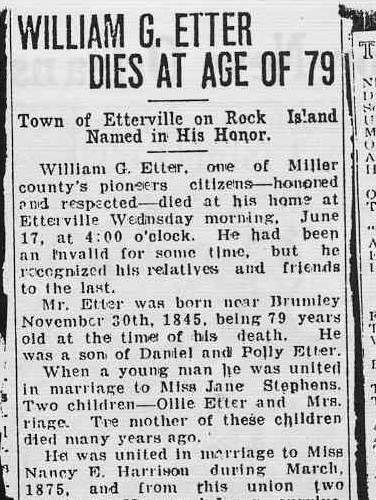
20 William G. Etter Obituary
Click image to view full obituary
William Miller was appointed by the County Court as Commissioner; John R. Morris and Lewis Atkinson, inspectors of the common schools in the district.
The tenth schoolhouse in Miller County was erected on the Andrew McCastland Plantation in 1851. A spring term of school was taught in that year. It was known as the Franklin school house, from which Franklin Township later derived its name. The Congressional Township in which this school was located was organized for school purposes pursuant to the law o 1845 in 1851. The inhabitants of Congressional Townships School District No. 3 met at the Franklin schoolhouse on the first Saturday in October, 1861. The County Court appointed Andrew McCastland, commissioner; Uriah S. Dooley and Wilson Alley, Inspectors of the common schools in the district. In 1854, John Brockman was appointed Commissioner of School District No. 3 by the County Court.
Dr. Popejoy and Wilson Allee, Directors of the Franklin school district in 1853, reported to the County Clerk:
“We the under signed Directors of School township No. 3 in County aforesaid in conformity with the statute in relation to common schools, do report that the whole number of entire school districts in our township is one, and that the number of entire districts, from which the necessary reports have been received, is on, within the time limited by law, and that from said report the following is a just abstract:
We the undersigned Directors of School Township No. 3 in County aforesaid in conformity with the statute in relation to common schools, do report that the whole number of entire school districts in our township is one, and that the number of entire districts, from which the necessary reports have been received, is one, within the time limited by law, and that from said report the following is a just abstract:
Districts from which reports have been received
Whole time school has been kept 3 months
Length of time kept by approved teacher as required by law 3 months
Amount of money received $27
No. of children taught 39
No. over 5 and under 20 years old 73
Amount paid for teacher’s wages in addition to public moneys $26.00
No. of times school has been made 1
And we the said Directors do further certify and report that the whole amount of money received by the Commissioner of said Township, during the year ending at the date of this report, and since the date of our last preceding report, is 27&12/100 Dollars and Cents of which $23.76/100 were received on the account of the State. $....Dollars on the account of the County, and $3.36/100 on account of Township School moneys; that the said sum has been apportioned and paid to the district from which the necessary reports were received by the directors. That the school books mostly used in our Township are Websters Elementary Spelling book, McGuffie’s Eclectric Readers, Smith, Smiley, and Ray’s Arithmetic, dated 1st day September, 1853.
D. Popejoy, Wilson Allee, Directors.
In March, 1851, the County Court organized fractional Congressional Township No. 38N, Ranges 14, 12, and 13W, into school districts numbered 15, 16, and 17, respectively.
The eleventh school house in Miller County was erected on the Big tavern Creek, north and slightly east from present day St. Elizabeth. Known as the Flaugher schoolhouse, a spring term of school was held and taught here in 1851. In the same year the Congressional Township in which the Flaugher school was located was organized for school purposes under the law of 1845. The inhabitants of Congressional Township School District No. 6 met at the house of Calvin and Owen Riggs on the fourth Saturday in March, 1852 (photo 21).
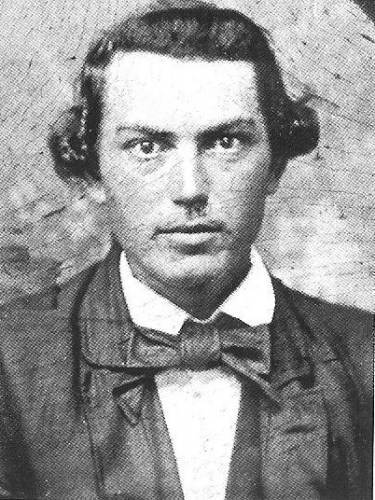
21 Owen Riggs - Founder of St. Elizabeth
Owen Riggs was appointed Commissioner by the County Court; John L. Fulkerson and John Goodwin, Inspectors of the common school in the district. In June, 1852, the County Court appointed John L. Fulkerson, Commissioner of District No. 6
On June 15, 1852, the County Court appointed Esquires John D. Popejoy for Saline; James Johnston for Jim Henry; E.B. Farley for Equality; Daniel Reed for Glaze; Jonathan Blevans for Richwoods; Levi Morgan for Osage, to ascertain the number of children of school age in the 17 school districts in Miller County. It took John D. Popejoy eight days to take the census of Saline Township for school purposes. He was allowed $13 for his services by the County Court.
The twelfth schoolhouse in Miller County was raised on the farm of Julius Schilwachter by the Big Tavern Creek, in Osage Township. In 1857, a spring term of school was taught in this building.
The thirteenth schoolhouse in Miller County was erected on the farm of Levi Whittle in southwestern Richwoods Township. A spring term of school was taught here in 1857.
The fourteenth school house was er4ected in 1857, near the George W. Robinson farm, in Glaze Township.
These were public schoolhouses, erected as district buildings. Other buildings used for school purposes were either church houses or privately owned dwellings.
First School Commissioner
Thomas J. Marshall was the first School Commissioner of Miller County. This was the infant beginning of the county superintendence of schools.
Marshall was appointed as school commissioner by the County Court on November 9, 1853, for a term of two years. The same day Commissioner Marshall presented to the Court his official bond with Abraham Castleman, Emanuel Godlove, and Champ Smith as securities, conditioned for the faithful performance of his duties, in a sum of $2,000 (photo 22).
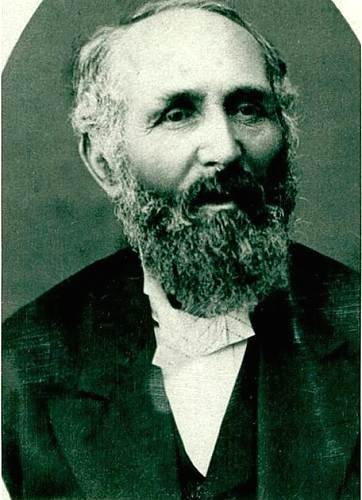
22 Emanuel Godlove
Comissioner Marshall received $119 for his services in the year of 1855. He served in the office until 1858, the E.B. Farley, County Clerk, assumed the duties of school commissioner. William M. Lumpkin replaced Farley in 1860 (photo 23).
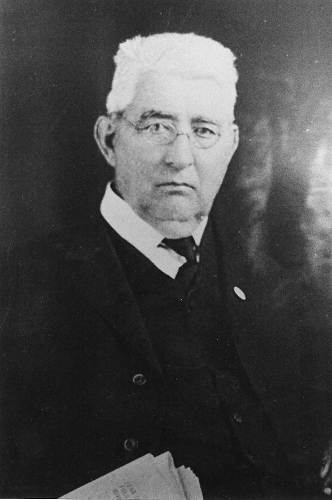
23 William Lumpkin
On August 4, 1854, the County Court appointed William M. Lumpkin examiner for Miller County schools with the duty to examine and grant certificates to teacher under the same rules and regulations governing county school commissioners. Afterward, teachers in the common schools of Miller County were supposed to be examined and granted certificates to teach, although little attention was given this requirement by school directors until after the Civil War.
The 17 Congressional Township School Districts established by the County Court were divided into sub districts as new schools were established. In 1856 there were 29 school districts in Miller County, but only 12 public schoolhouses. There were 10 men and 2 women teachers. The number of children between the age of 5 and under 20 totaled 2,458, but only 456 children attended school. Teachers in the common schools of Miller County that year were paid $518.17 for their services, which averaged approximately $70 per teacher.
In 1857 there were 43 school districts in Miller County, and 14 schoolhouses. There were 22 men teachers; no women teachers. Children between 5 and 20 years of age, totaled 2,572; number actually enrolled in school, 926. The amount paid to teachers for their services during the year was $1,682.77 which averaged approximately $76 per teacher. The amount raised by taxation to build and repair school houses was $14.00. This was the first tax levied and collected in Miller County for school purposes, although under the law of 1853, directors were empowered to levy a tax on both personal and real property. Here was the beginning of our present public school system.
Early Teachers and Trustees
Early school teachers in Miller County included Silas Capps, Meredith Bowman, W.N. Harrison, Elisha Glass, Sebastian William, Jonathan Blevans, E.B. Farley, Samuel Allen, Thomas J. Marshall, Evan Short, Jesse Gott, James McMillen, S.T. Harrison, W. McComb, J.S. McComb, S. Bozarth, Haman Dyer, John Brockman, and J. Milton Houston. These were teachers who organized schools in the 1830’s and 40’s, of two or three months duration, for wages paid in part through boarding around arrangements for “hog and hominy” and a place to sleep.
Thomas J. Marshall was probably the first teacher of public schools in the Pleasant Mount community; J. Milton Houston near Rocky Mount, E.A. Henry probably taught the first school in the village of Tuscumbia; E.B. Farley in the vicinity of Bagnell, Silas Capps probably taught the first schools in Osage Township; Jonathan Blevans in Richwood Township; John T. Gilleland teacher of the first public schools around Olean; Elisa Glass near Brumley.
School Trustees in the 1857-59 era included Lewis Atkinson, Edward Henderson, J.M. Richardson, Joel Bond, Ludwell Bacon (photo 24), and William Etter in Congressional Township School District No. 1; J.J. Adcock, C.T. Atkinson, J.H. Todd, A.M. Houston, and John L. Gilleland in Congressional Township School District No. 2; U.S. Dooley, William Wadley, John D. Reed, and Samuel T. Harrison in School District No. 3; James Johnston, James L. Wright, Hugh Gartin in School District No. 4; John J. Denton, Silas Capps, Bruce Irwin and J. L. Palmer in School District No. 5; Owen Riggs, John L. Fulkerson, William Pendleton, and F.Flaugher in School District No. 6; George Wilson, J.A. Stone, and W.A. Long in School District No. 7; L. W. Albertson, and Belche brothers in School district No. 8; Daniel Cummings, Thomas Scott (photo 25), W. Loveall, William McComb in School District No. 10; W. L. Dodds, Jonathan Loveall, and I.S. Harrold in District No. 11; F.G. Hale, J.S. McComb, J.H. Hix, and W. Hawkins in School District No. 12; (photo 26); S. Bozarth, W.C. McCubbin, Haman Dyer, and J.L. West in School District No. 13; William Rowden, Henry Jones, T.J. Dickerson, J.H.C. Branham, and J. Johnston in School District No. 14; Bluford Benton, J.E. McComb, and August Thornsberry in School District No. 15; John W. Record, James McMillen, and Thomas Brown in School District No. 16; C.D. Martin, W.O. Short and B.W. Acuff in Congressional Township School District No. 17.
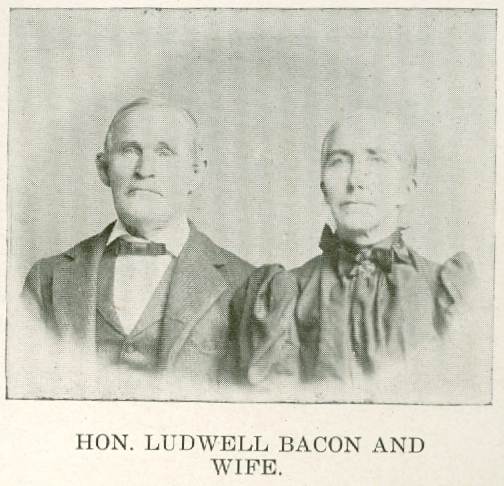
24 Ludwell Bacon and Wife
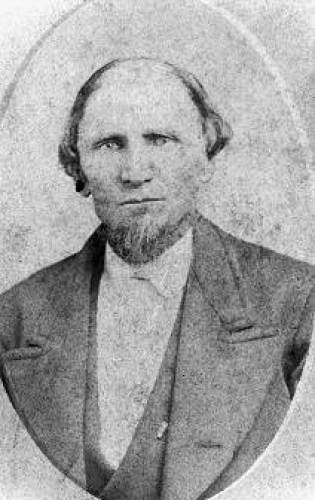
25 Thomas Scott
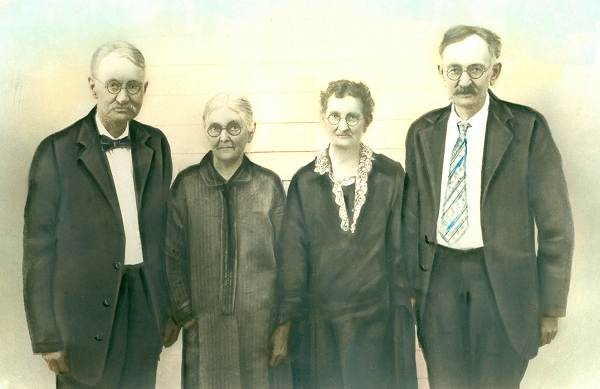
26 Siblings: James Hawkins, Mary Hawkins, Cynthia Hawkins Spearman and William Hawkins
Progress In Education
Progress in education under the law of 1845, and 1855, was slow in Miller County. The schools during this early period were likened to the clothing worn by the scholars, largely of home spun varieties. School buildings were of logs, with rock chimneys and fire places, puncheon log floors and split log benches, and for windows a log was cut and the opening covered with greased paper or a wooden shutter hung on leather hinges.
Note: almost all the early school houses were made of logs but later replaced by frame or concrete buildings. Two of the log school houses which survived long enough for a photo were the old Capps and Pleasant Grove schools (photos 27 and 28).
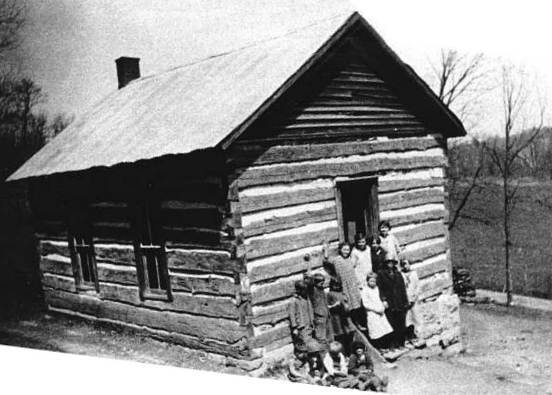
27 Original Log Capps School
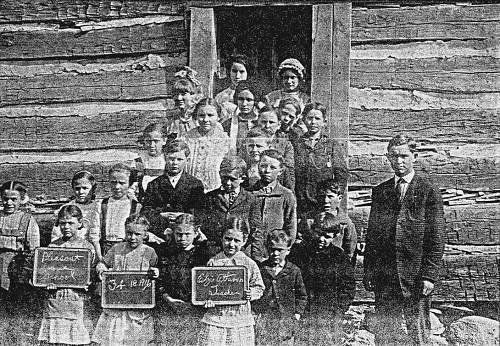
28 Pleasant Grove School
Usually, the first child to school was privileged by the teacher to select a seat for the day, which was important. In the winter a seat would be chosen nearer the fireplace; in the spring by the cut log window. The older boys first reaching the school building were privileged to cut a backlog for the fireplace and get in wood and water for the day.
The students, in age, often ranged from four years to grown men and women. In earlier days the students wore clothing of leather breeches, jackets, and skirts; later, linsey Woolsey (a coarse, woven fabric of wool and cotton or of wool and linen) pantaloons and dresses.
Without any doubt the students were tough physically. A traveler through the county before the Civil War reported there were many grown girls who wore no shoes, but that on school paths their hardened feet struck fire from the flint rocks. He indicated all of the boys of school age could be tolled with a basket of soda biscuits to St. Louis.
Probably this was an exaggeration, but if students were tough physically, teachers were tougher! Hickory sticks occupied prominent places in the school rooms, and the abilities of teachers to discipline their schools was an important part of their qualifications. “Lickin’ and Larnin’” were the rules of the school trustees, and parents. It may be written that in this era parents were more like schoolmasters to their children; schoolmasters more like overseers of houses of correction. Children stood in respectful silence before their parents when in their presence, but trembled at the sight of their schoolmasters, and did not dare speak without permission.
The required studies were reading, writing, and arithmetic, with spelling, and later, geography and grammar added. In the beginning teaching was limited to the keeping of simple accounts as a farmer or village storekeeper, and how to cast an intelligent vote on the issues of the day. The mere ability to read and write and cipher correctly distinguished an educated person from the uneducated.
School supplies were at such a premium, oral instructions from Webster’s spelling book, Smiley’s arithmetic, Kirkham’s grammar, and the Bible were the order of the day. Lead pencils were hardly known before the Civil War, a few made by hammering out lead shot. Pens were made from choice quills fresh pulled from the honking gander, while ink was made by boiling walnut hulls and sometimes polk berries. For ciphering and writing, chalk and slates were used.
Early Problems
On December 28, 1859, William Abbott, a schoolmaster, sued John O. Carleton, William Wright, and Hezekiah Robinett, Trustees of a sub district school in Congressional Township School District No. 12, located near the present day village of Brumley, on an account of five dollars for schooling of one scholar signed to a six month school in July, 1858, offset by a sow credit of two dollars. The following persons, Willam G.B. Winfey, Bluford Barton, Samuel Pennington, and Thomas Winfrey, were sworn as jurors to decide the case in a Justice of the Peace Court, and after hearing the evidence, returned into Court the following verdict: “We the jury find for the Plaintiff (Abbott) the sum of three dollars. Thomas Winfrey, Foreman.”
Note: William Abbott was my great great grandfather.
Barnabus Reed, Robert Reed, Hiram Reed, and James B. Reed, by their next friend, David Reed, in an action of trespass, complained that on July 24, 1848, the Reeds were at a reading and writing school in the peaceable enjoyment of their liberties, under the care of their teacher, when and where they were sent, and directed to go, by their parents; and the next day, Elisha W. Glass, envying their happy condition and seeking willfully and maliciously to injure, harass, imprison, impoverish, and wholly ruin them, did willfully and maliciously arrest, take, and imprison them, the space of fifty days, without any Just, reasonable, or probably cause, or without any writ, warrant, or other legal authority. This caused the Reeds to lay out and expend various large sums of money in exonerating and defending themselves from this attack…the sum of $100. That Glass did willfully maliciously, and with intent to injure them acted under the color of a justice of the Peace, which caused the Reeds to suffer greatly in bodies and minds, and injured them to the amount of $1,000 in sustained damages.
First Student In University
In the 1856-57 session of the University of Missouri, William V. Allen, 20 years of age, from Miller County, was the first student listed in a roster of 1670 attending this higher institution of learning. He was probably the first person from Miller Count to attend the University of Missouri.
In 1856 the largest school district in Miller County, according to the number of children in school, was Congressional Township School District No. 1, which included the present day communities of Spring Garden, Etterville, and Mt. Herman. The second largest, Congressional Township School District No. 2, included the present day communities of Olean, Mt. Pleasant, and most of the city of Eldon. The third largest was district No. 10, the Congressional Township in which the village of Bagnell now is located. The fourth largest was Congressional Township School District No. 12, in which the village of Brumley is presently situated.
On February 25, 1859, the County Court, by actual count, ascertained the amount of money due each school district, and apportioned the money for the payment of teacher’s wages, a sum of $1,852.06. This would have averaged about $43 to each school. An examination of the rates paid teachers in the several schools before the Civil War, factually presented that teachers were paid about $15 a month without board, while ox drivers were paid $15 a month with board.
A joint resolution of the General Assembly, approved May 12, 1861, diverted the state school fund monies from educational purposes to those of war and rebellion.
One of the earlier high schools in Miller County was at Tuscumbia. It was combined with the grade school in a frame building a short distance south of where the present school is now located. It was the third school in Tuscumbia (photo 29).
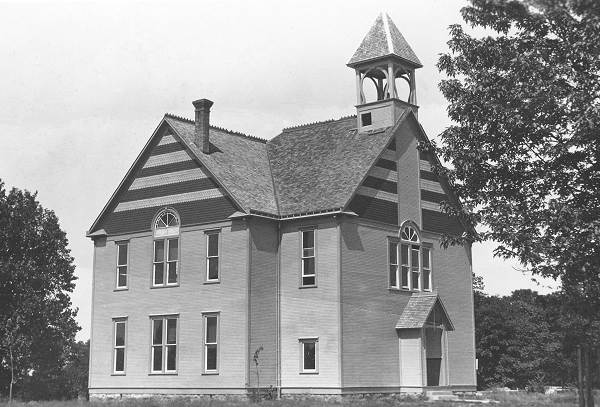
29 Third Tuscumbia School
The story of its demolition and replacement by the fourth school building was written in an article placed in the Autogram in 1926:
Tuscumbia Public School Building,
Constructed 1895 Now Being Torn Down
Miller County Autogram
May 27, 1926
Another old Tuscumbia land mark is disappearing this week. This time it is the frame public and high school building, which has been serving a good purpose since 1895. No more will the tread of the boys’ and girls’ feet be heard as they wend their way up the crooked stairway. No more will the auditorium ring with the laughter of boys and girls. It is doomed to destruction, and is now partially dismantled. Some of the material is to be used in the new brick building and the remainder will be sold, the proceeds to go to the district fund. The old bell is removed from the belfry from which it has called countless number of youth of our town to attend school.
This bell has a history which goes back several generations. It was used during the time of the old brick building which was torn down nearby in 1895. G.P. Swanson says the bell was in use in 1884 when he taught the Tuscumbia school and he says he thinks it was in use many years before that time (photo 30).
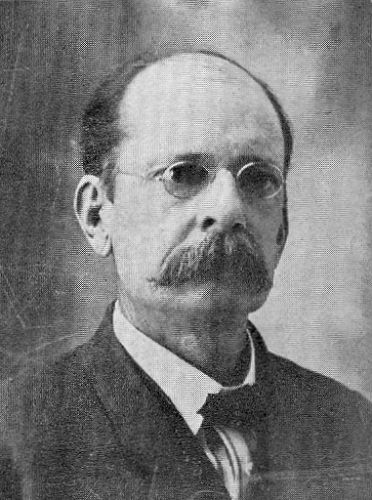
30 George P. Swanson
A suitable place should be provided for the old bell and it should continue to do its duty when the new building is completed.
The frame building was constructed in 1895. Agitation was begun early in that year to construct a new building, as the old brick building was considered unsafe any longer.
Plans were drawn and a proposition for voting $2,600 for the building was considered. The desire of the district seemed to be to construct a brick building. Estimates received from Miller and Opal, Jefferson City architects. They advised that it would take $4,000 to construct the building of brick and there was agitation to ask this amount in a bond issue.
At the annual meeting held April 2, 1895, the question was decided in favor of the frame building. P.F. Hauenstein was elected a member of the school board, and the other two members were L.N. Musser and G.P. Swanson (photo 31).
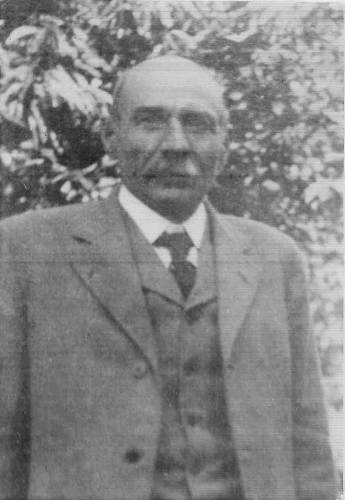
31 Phil Hauenstein
At the same time, the bond issue was raised from $2,600 to $3,000 for the construction of the frame building contemplated. This carried.
On the 18th day of May 1835, the contract was awarded to J.P. (Jim Pink) Tomson for building the new schoolhouse, at his bid of $2,558.65. Bonds were issued to run 10 years and draw 6% interest. The building was not completed until the first of December, 1895.
The building will be replaced by a modern brick building, 72x76 feet in dimensions, with a heating plant of two furnaces. A bond issue of $12,000 was voted a year ago. The district will have about $4,000 available from other sources this year, including cash on hand and material to be salvaged from the old building. Some of the interior work will be unfinished at the present time, and it is contemplated that this can be finished in a few years without any additional bond issue, making the total cost of the building when completed approximately $20,000.
The next school which was Tuscumbia’s fourth was of brick construction and was discussed in an article in the Autogram in 1926 at the time the third school was being taken down:
Tuscumbia’s New Public School Building (photo 32)
Miller County Autogram
December 16, 1926
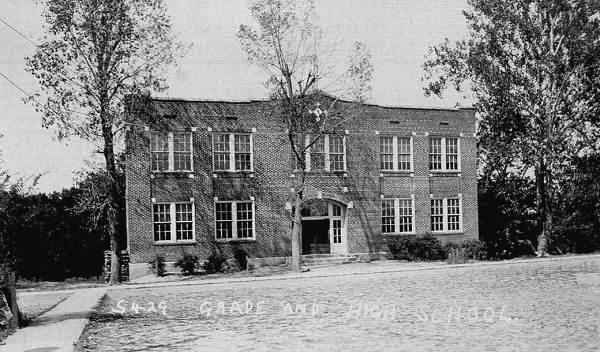
32 Tuscumbia Grade and High School before 1938
The above is a picture of Tuscumbia’s new public school building which is now practically completed with the exception of some minor features to the gymnasium.
This building, which is the fourth school building Tuscumbia has had, is of brick construction, and is 72x76 feet in dimensions. There are two grade rooms on the first floor, and a study hall, three class rooms, a library and the superintendent’s office on the second floor. The rear portion of the building is a combined auditorium and gymnasium and is 72 feet long. The building is adequately heated with two furnaces and electrical wiring has been installed in contemplation of the future.
This building is quite a contrast to Tuscumbia’s first school house so far as known by those living today. The first seat of learning here was built of logs and was about 16 feet square. It stood in the northeast corner of what is now the George T. Nichols yard. It was built sometime before the Civil War.
About the year 1873, the town decided it wanted something better so a one story, one room building was constructed of brick, and the site of this building was on the hill just to the east of the old building, which was torn down last summer.
Brick for this building was made here.
In about 1895, the building was judged unsafe and inadequate, and a bond issue was voted for the construction of a frame building to cost approximately $2,500. This was of frame construction, and had two grade school rooms downstairs, and one room upstairs for high school purposes (see photo 29 above).
Then came the present school building of concrete and brick construction, and costing, when completed, approximately $20,000. And it is a building that is indeed a credit to a town the size of Tuscumbia.
I have discussed previously in past Progress Notes well respected citizens of Miller County who had great influence regarding the progress of education in our county. These included Thomas Everett Vaughan, T.C. Wright, Carroll McCubbin, C.D. Snograss and Professor Byron Smith. You can read more about these educators of the past at these previous Progress Notes:
T.E. Vaughan
(photo 33)
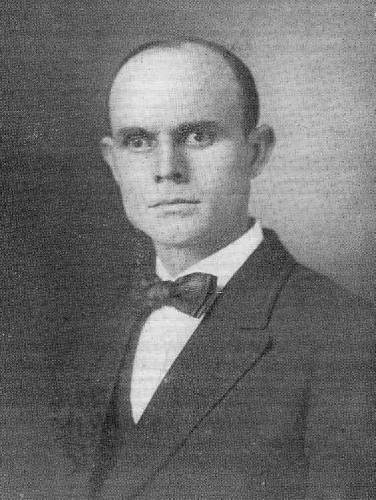
33 Thomas Everett Vaughan
Tennyson Clay Wright (photo 34)
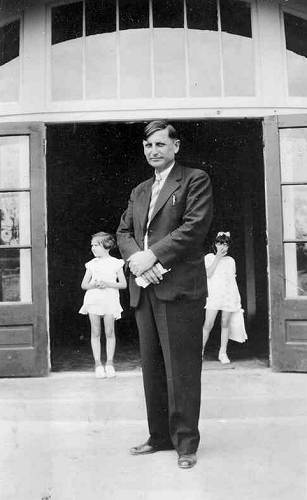
34 Tennyson Clay Wright
Carrol McCubbin (photo 35)
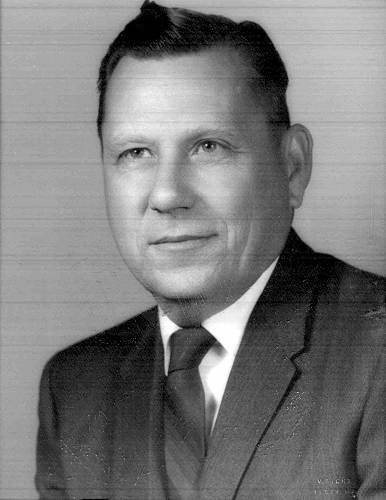
35 Carrol McCubbin
C.D. Snodgrass (photo 36)
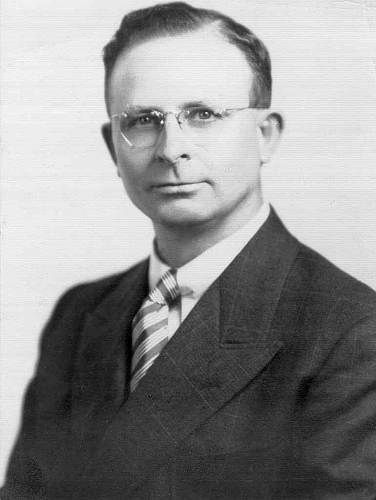
36 C.D. Snodgrass
Professor Byron Smith (photo 37)
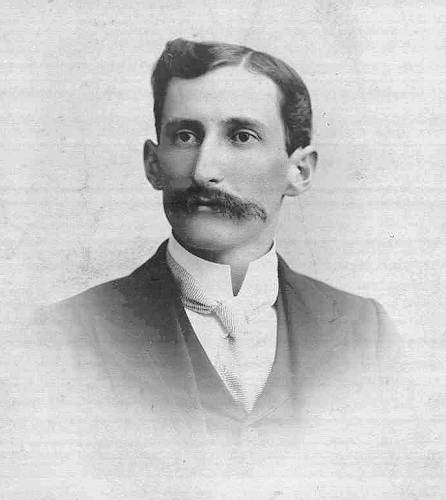
37 George Byron Smith - Iberia Academy
Another person who had important influence in the early part of the last century was Roy Starling (photo 38).
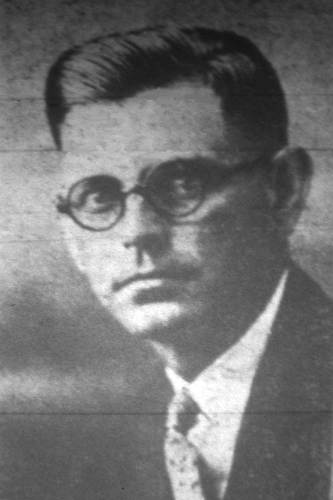
38 Roy W. Starling
Here is a biography of him written by his wife, Mary Starling copied from our website:
Roy Starling Biography
By Mary Brockman Starling, 1981
Roy W. Starling was born August 26, 1898, near Olean, Missouri. His father, Thomas Starling, died when Roy was 19 years of age. His mother, Mettie Starling, died in 1939.
Roy attended Olean and Eldon High schools and Central Missouri State (then) Teachers College and Missouri University at Columbia.
He served as County Superintendent of Public Schools (1922-1927) being the youngest ever to serve in the state. He also was Superintendent of Brumley High School. On July 1928 he was licensed to practice law as an attorney and counselor at law. Soon thereafter he and Harry H. Kay, a prominent attorney in Eldon, formed a partnership known as "Kay and Starling" for the general practice of law with offices in the Buehler Building.
On November 22, 1930, Roy was married to Mary Brockman, the only surviving daughter of Judge J.N. Brockman and wife, Eliza C. Wilcox Brockman, of Tuscumbia, Mo. A daughter, Betty Nell was born October 14, 1931, who attended Central Missouri University at Warrensburg and Missouri University at Columbia and St. Louis. She married Robert J. Semple. Betty Nell taught school sixteen years and is now a graduate of real estate institute with license to sell real estate in the State of Kansas.
During the preliminary preparation of the building of the dam, Roy worked with Baker, Botts, Parker and Garwood, attorneys, in obtaining possession of the land in Camden, Miller, Morgan and Benton counties, which is now inundated by the Lake of the Ozarks and continued with the Union Electric thereafter.
Miss Brockman also worked with Kansas City Title and Trust Company in perfecting the title to the land being inundated by the Lake of the Ozarks. Roy served as city attorney of Eldon many years. (He resigned in 1948).
He was elected Prosecuting Attorney in 1934. He was a member of the Missouri Bar and served on many committees. He was Government Appeal Agent for Selective Service of Miller County and County Chairman for American Bar Commission on War Work. He received Selective Service Medal of Merit for this work.
He served on Eldon School Board many years and was appointed to Board of Regents for Central Missouri State College (now Central Missouri State University). He resigned in 1948 because of ill health.
Roy's interest in civic affairs led him into the activities of the following: Masonic Lodge; Eldon Lions, being District Governor; and the Chamber of Commerce. He was a member of the Eldon Baptist Church and active in church affairs.
Some of his beliefs of the duties of enforcement officers were found among his files which include the following: "That justice be done - for justice sake; not just to convict. To represent all the people including the defendant he is prosecuting. He may strike hard blows, but never foul ones; fair to everybody; to be a prosecutor, not a persecutor."
One of Roy’s achievements early on was the organization of Miller County teachers in the Miller County Teachers Organization as described in this article from an old edition of the Autogram:
Miller County Teacher Enrolled 100 Percent
Miller County Autogram
June 24, 1926
Superintendent Starling tells How He attained 100 Percent Enrollment
In the following article “The School and Community” presents a brief biography and statement from County Superintendent Roy W. Starling of this county how he attained 100 percent enrollment of teachers in the Miller County Teachers Association.
Roy W. Starling, superintendent of schools of Miller County was born and reared on a farm near Olean, and was educated in the rural school near his home, the Olean and Eldon High Schools, the University of Missouri and the Central Missouri State Teachers College. He taught in a rural school and was for three years superintendent of the Brumley schools.
On October 10, 1922, he was appointed county superintendent by Governor Hyde to fill the vacancy caused by the resignation of H.M. Atwell. The following April he was elected for a term of four years.
He says of his 100 % professional cooperation: “During my term my chief work has been to raise the qualifications of the teachers of the county. This I did by sending all the papers to the State Department for grading. Then we tried to cooperate as best we could with the State Department in all its plans. Also, the work done by the parent teachers organization of the county has been worth while.”
“We desired 100 % enrollment in this county, because we realized that most things worth while in educational matters had been secured through the efforts of the M.S.T.A. (Missouri State Teachers Association) and if we wanted anything better, the best way to get things done was to present a united front. Then, too, if teachers cannot stand as one in their efforts for educational advancement, we cannot expect much of other folks. If anything is worth doing, it is worth doing right.”
“We were enrolled 100% by never giving up. At first, the teachers were given an opportunity to enroll without any persuasion. Most of them enrolled then. A check up followed and all who had not enrolled were sent personal letters. During the past year no trouble was experienced at all. At the first opportunity the teachers enrolled. No certificate is renewed nor has been renewed since my time in office unless the holder was a member of the State Teachers Association. Now I am of the opinion that every teacher in the county would go to some trouble of their own to become a member. They see the good they and the others are doing.”
Roy Starling’s obituary adds more information about his life and career:
Roy Starling Obituary
Prominent Attorney and Citizen of Eldon Died Here Saturday (photo 38a):
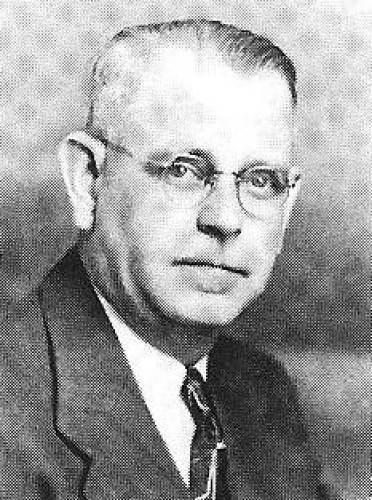
38a Roy Starling
Funeral services were held Sunday afternoon for Roy W. Starling, 50, prominent Eldon Attorney, who died at his home here early Saturday morning, following an illness of nearly two years. Reverend Malcolm Younger conducted the services at the First Baptist Church of Eldon, and burial was made in the Eldon Cemetery under direction of Phillips Funeral Service.
Starling was a highly known attorney and highly respected citizen of Miller County. He served as prosecuting attorney of this county from 1934-1939 and prior to that time was county superintendent of schools. While holding the latter office, he studied and obtained his license to practice law. Later, he formed a law partnership with Harry Kay in Eldon, and continued in that partnership until his death. Starling served as city attorney of Eldon for many years, resigning in April of last year.
His interest in public schools continued after his term as county school superintendent. Starling served on the Eldon School Board and was a member of the board of regents of Central Missouri State College until he was forced to resign because of ill health. He was always interested in civic affairs and was a member of the Masonic Lodge, Lions, and the Chamber of Commerce. He was a member of the Eldon First Baptist Church and active in church affairs.
Starling was the eldest son of Thomas and Mettie Starling and was born near Olean, Missouri, August 26, 1898. His parents preceded him in death, his father having died when he was 19 years of age. His mother died in 1939.
On November 22, 1930, he married Mary Brockman. They were parents of one daughter, Betty Nelle. Besides the mother and daughter, one brother, Golder G. Starling of Olean, Missouri survives.
Starling attended public schools of Miller County and graduated from Eldon High School. He also attended Central Missouri State College and the University of Missouri.
Pallbearers for the funeral service were John Walker, C.R. Hawkins, W.W. Harvey, Ralph Reed, Dr. E.O. Shelton, and Glenn F. Leslie. Out of town attorneys who attended the services were A.J. Bolinger, R.H. Wood, G. Logan Marr, and W.M. Boles of Versailles; John Windsor and H. Martin Winters, Boonville; Frank Brady and Edwin Brady of Warsaw; Hugh Phillips and James T. Roach of Camdenton; John T. Martin of Sedalia; Judge James Hawkins of Buffalo; and W.S. Stillwell, C.D. Snodgrass, and Jack Stanton of Tuscumbia.
Reverend D.W. Jones of Overland, Missouri, former pastor of the Eldon Baptist Church, sang a special number at the service.
By all accounts the Miller County Historical Society chili dinner/car show presented Saturday, October 15 was a great success! About a hundred dinners were served and many raffle tickets were sold at the door as well. Jack Brumley and his crew presented the show cars on the courthouse parking lot which was a very successful manner of attracting passersby as well as giving us more room for parking at the museum grounds. Connnie Prather earlier in the week had prepared the kitchen and she and her crew served the chili and desserts very efficiently. I heard many positive comments from our guests about the event and the museum itself. We had visitors from the east coast (Jim and Dana Maloney) and the west coast (John Warren) as well I am sure from other points far away. Joe Jeffries' musicians once again provided excellent entertainment with a variety of performers and musical numbers. His presence makes for a very convivial atmosphere for our guests who can choose to eat, talk, listen or all three!
Winners of our raffle for this year were:
1. Quilt made and donated by Elva Steen: won by Judy Patterson of Tuscumbia*
2. Savings Bond donated by Citizen’s Bank of Eldon: won by Louise Martin of Eldon
3. Savings Bond donated by Central Bank of Tuscumbia: won by Connie Prather of Iberia
4. Fifty dollars cash donated by Bank of St. Elizabeth: won by Waldo Steen of Weatherford, Texas
*Note: Here are photos of Elva and the quilt (photos 38b and 38c):
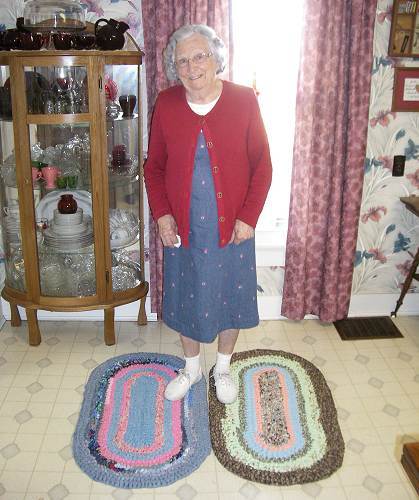
38b Elva Steen and Two Rag Rugs
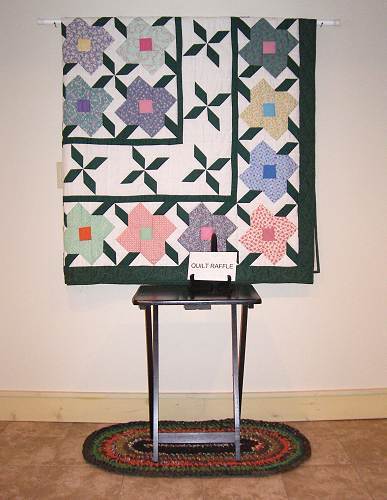
38c Hand Crafted Quilt and Rag Rug donated by Elva Steen for Annual Raffle
Here is a collage of photos taken at the event (photos 39 - 45):

39 Cars

40 Cars
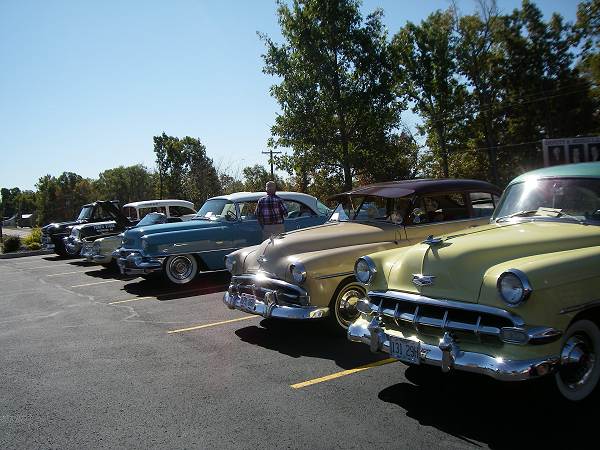
41 Cars
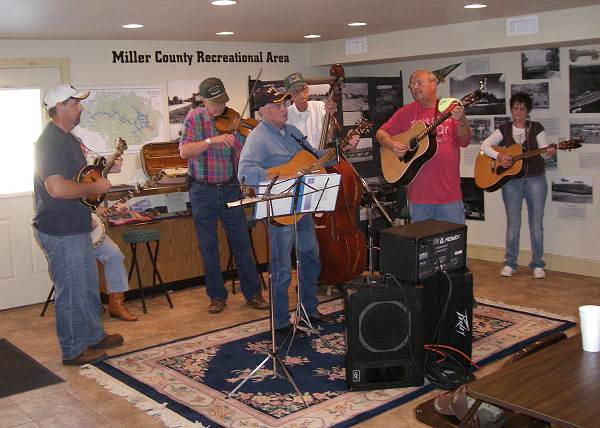
42 Joe Jeffries Band
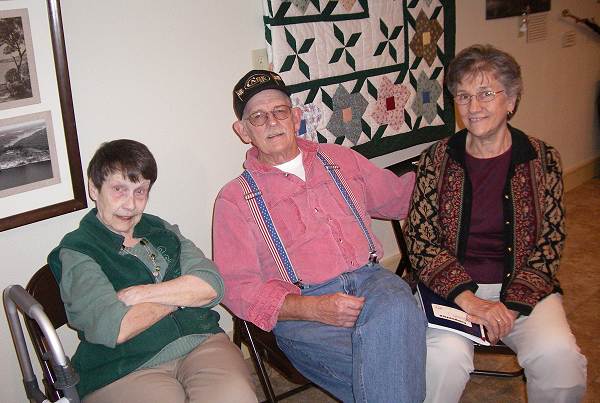
43 Susie Pryor, Harold and Joy Flaugher
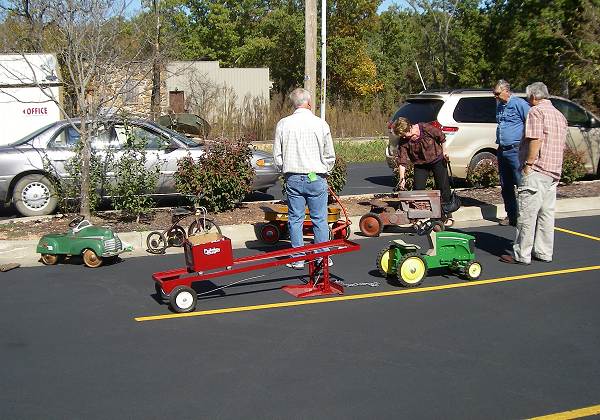
44 Greg Keeth with Kiddie Tractor Pull Contest
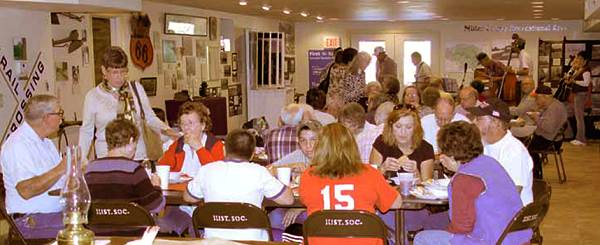
45 A chili luncheon was popular Saturday, Oct. 15, at the Miller County Historical Society Museum
in Tuscumbia. Dozens of people enjoyed a car show, the meal and music by local entertainers.
(Photo by Ginny Duffield)
That’s all for this week.
 Joe Pryor
Previous article links are in a dropdown menu at the top of all of the pages.
|

